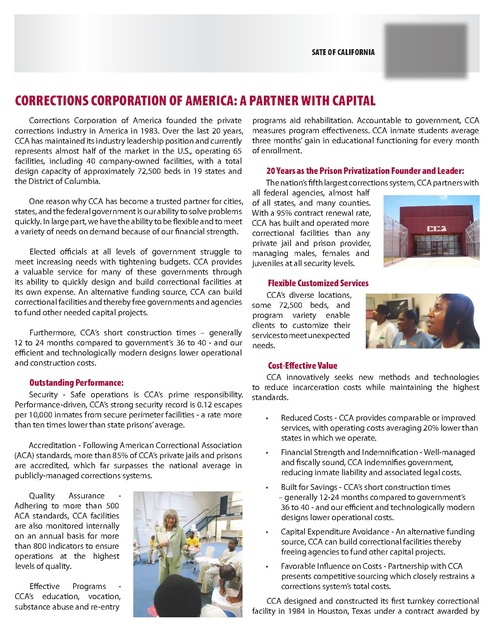Cca State of California a Partner With Capital Promotional Sheet
Download original document:

Document text

Document text
This text is machine-read, and may contain errors. Check the original document to verify accuracy.
Sate of California Corrections Corporation of America: A Partner With Capital Corrections Corporation of America founded the private corrections industry in America in 1983. Over the last 20 years, CCA has maintained its industry leadership position and currently represents almost half of the market in the U.S., operating 65 facilities, including 40 company-owned facilities, with a total design capacity of approximately 72,500 beds in 19 states and the District of Columbia. One reason why CCA has become a trusted partner for cities, states, and the federal government is our ability to solve problems quickly. In large part, we have the ability to be flexible and to meet a variety of needs on demand because of our financial strength. Elected officials at all levels of government struggle to meet increasing needs with tightening budgets. CCA provides a valuable service for many of these governments through its ability to quickly design and build correctional facilities at its own expense. An alternative funding source, CCA can build correctional facilities and thereby free governments and agencies to fund other needed capital projects. Furthermore, CCA’s short construction times – generally 12 to 24 months compared to government’s 36 to 40 - and our efficient and technologically modern designs lower operational and construction costs. Outstanding Performance: Security - Safe operations is CCA’s prime responsibility. Performance-driven, CCA’s strong security record is 0.12 escapes per 10,000 inmates from secure perimeter facilities - a rate more than ten times lower than state prisons’ average. Accreditation - Following American Correctional Association (ACA) standards, more than 85% of CCA’s private jails and prisons are accredited, which far surpasses the national average in publicly-managed corrections systems. Quality Assurance Adhering to more than 500 ACA standards, CCA facilities are also monitored internally on an annual basis for more than 800 indicators to ensure operations at the highest levels of quality. Effective Programs CCA’s education, vocation, substance abuse and re-entry programs aid rehabilitation. Accountable to government, CCA measures program effectiveness. CCA inmate students average three months’ gain in educational functioning for every month of enrollment. 20 Years as the Prison Privatization Founder and Leader: The nation’s fifth largest corrections system, CCA partners with all federal agencies, almost half of all states, and many counties. With a 95% contract renewal rate, CCA has built and operated more correctional facilities than any private jail and prison provider, managing males, females and juveniles at all security levels. Flexible Customized Services CCA’s diverse locations, some 72,500 beds, and program variety enable clients to customize their services to meet unexpected needs. Cost-Effective Value CCA innovatively seeks new methods and technologies to reduce incarceration costs while maintaining the highest standards. • Reduced Costs - CCA provides comparable or improved services, with operating costs averaging 20% lower than states in which we operate. • Financial Strength and Indemnification - Well-managed and fiscally sound, CCA indemnifies government, reducing inmate liability and associated legal costs. • Built for Savings - CCA’s short construction times – generally 12-24 months compared to government’s 36 to 40 - and our efficient and technologically modern designs lower operational costs. • Capital Expenditure Avoidance - An alternative funding source, CCA can build correctional facilities thereby freeing agencies to fund other capital projects. • Favorable Influence on Costs - Partnership with CCA presents competitive sourcing which closely restrains a corrections system’s total costs. CCA designed and constructed its first turnkey correctional facility in 1984 in Houston, Texas under a contract awarded by Sate of California Corrections Corporation of America: A Partner With Capital (page 2 of 2) the Immigration & Naturalization Service. This first facility, the Houston Processing Center, was constructed in record time - 6 months - and is still under contract with the Bureau of Immigration and Customs Enforcement today. Since that first facility in 1984, CCA has designed and constructed another 33 turnkey facilities, and renovated or expanded another nine facilities, both owned and managed-only. These projects range in size from 100 beds to over 2,300-bed facilities. Philosophy CCA began with a simple philosophy - to build cost-effective correctional facilities utilizing building techniques, materials and systems that are easy to maintain, durable and secure and that have a life expectancy of 30-50 years. Today, that same philosophy still stands. Another significant objective for each project is to design facilities that minimize staff requirements and operating costs, thereby lowering operational costs. We can then offer these savings to our customers. Early involvement is the key Along with using a prototypical design that CCA has refined over the years, early involvement by the design and construction team members is the most important factor in CCA’s ability to bring a facility on-line in record time. CCA has long-standing relationships with certain architectural/engineering and construction firms that we have worked with over the years and that know our projects. By using the same firms and very similar designs each time, we save countless hours of time and energy. As an example of the speed with which CCA can bring a facility on line, using a modified design/build process CCA’s 1,600-bed Florence Correctional Facility in Florence, Arizona reached substantial completion in 11 months, and was ready for occupancy less than 14 months from project approval and the start of design drawings. That kind of aggressive timeline is unheard of in the public sector.

